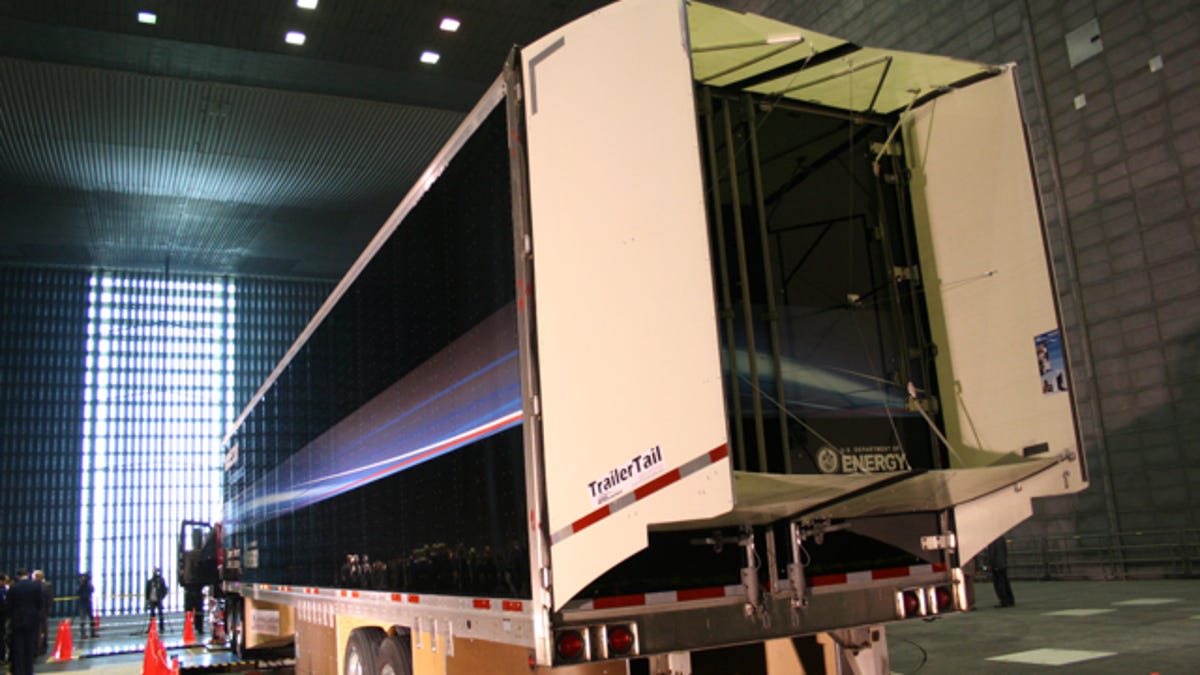Devices under testing at NASA may save trucking billions
Public-private partnership finds devices added to the nation's trucks could increase fuel efficiency by up to 12 percent, saving the industry more than $10 billion a year.

MOUNTAIN VIEW, Calif.--The American trucking industry could save as much as $10 billion, or 3.4 billion gallons of diesel fuel, a year if devices being tested in a joint public-private initiative at the world's-largest wind tunnel here are rolled out nationally.
Over the last few weeks, a partnership between the Lawrence Livermore National Lab, the U.S. Air Force, the NASA Ames Research Center, and the conglomerate, Navistar, has been conducting tests on the aerodynamics of tractor-trailer trucks. The findings indicate that new devices could be added onto the nation's thousands of trucks that could increase fuel efficiency on the vehicles by 12 percent.
The physical tests were conducted at the National Full-Scale Aerodynamics Complex--the world's largest wind tunnel--at NASA's Ames Research Center here, as well as on supercomputers at the Lawrence Livermore National Lab. The idea behind the partnership was to find a way to help the trucking industry--and by extension, almost every other segment of the economy--cut costs on fuel, and at the same time, reduce carbon-dioxide emissions.
The impact on the environment of the 12 percent increase in fuel efficiency, explained Lawrence Livermore National Lab (LLNL) Director George Miller, would be an annual reduction of carbon-dioxide emissions of 36 million tons.
The efficiency gains will come as a result of a series of novel devices, effectively skirts that protrude off the rear or drop below a trailer that are designed to reduce the wake size of a trailer, said LLNL senior scientist Kambiz Salari. The tests have been conducted to find the most efficient combination of the devices.
According to Salari, the U.S. Department of Energy will take the results of the wind-tunnel tests and apply them to a series of road tests and other experiments to ensure that the findings are applicable to industry. If so, the devices could be made available to private trucking companies within two and a half to three years, he said.
All told, Salari added, the findings are based on 15 years of research.
"Think of a trailer as a box," Salari said. "We're trying to trick the (air) flow into thinking the box is more aerodynamic."
The idea, he said, was to figure out how best to reduce drag that comes when air hits different parts of a truck as it speeds down a highway. By covering certain parts of the truck, drag can be reduced, Salari explained.
And while much of the flow physics research into finding the efficiencies was conducted on LLNL's Linux cluster supercomputers, the wind tunnel tests were necessary for a "sanity check" for the researchers, Salari said.
For now, the testing has been entirely about aerodynamics, Salari said. Actual operational testing that will consider additional factors such as the safety of the new devices, will come later.
The wind tunnel
Originally run by NASA Ames, the wind-tunnel has for years been the purview of the U.S. Air Force's Arnold Engineering Development Center, in Tennessee, despite its continued location in Mountain View and the continued participation by NASA researchers.
The tunnel has six 40-foot diameter fans which collectively draw as much as 106 megawatts of power, and which draw between 25 miles an hour and 80 miles an hour of wind, explained Joe Sacco, the chief NASA engineer at the wind tunnel. In general, it is used to test the aerodynamics of aircraft, but occasionally is used by clients such as Navistar, in cooperation with public institutions like LLNL.
Sacco said the tests are conducted not only with wind being applied head on to a vehicle, but also at a series of different angles, from zero degrees to 15 degrees.
"By measuring the drag force on the vehicle," Sacco said, "we can determine which add-on devices reduce drag the most."
He said the measurements are done by a scale system below the floor of the wind tunnel that the truck is mounted on, which can "resolve forces down to 12 to 15 pounds of drag."
Corrected at 7:50 p.m. PST: This story originally reported that the National Full-Scale Aerodynamics Complex was directed by Arnold Air Force Base in Galveston, Texas. In fact, it is run by the Arnold Engineering Development Center, which is located in Tennessee.

